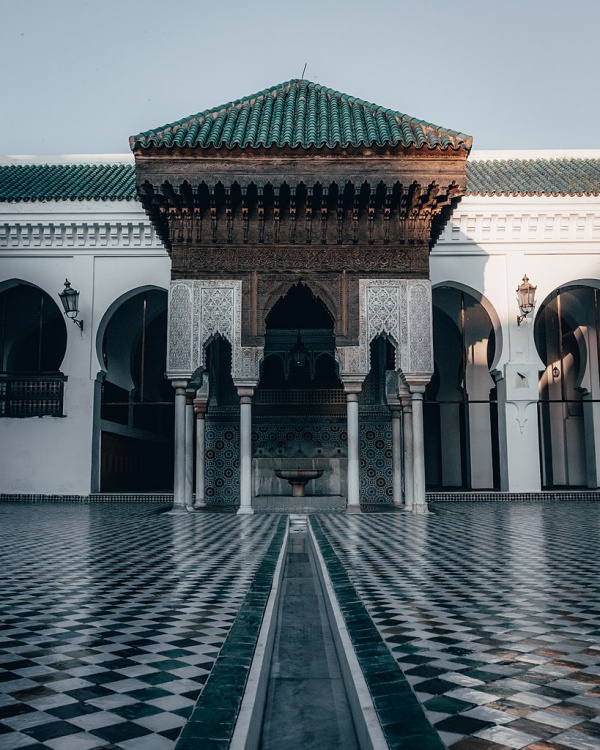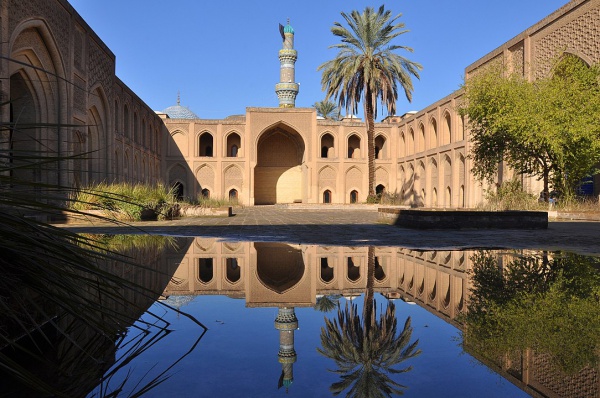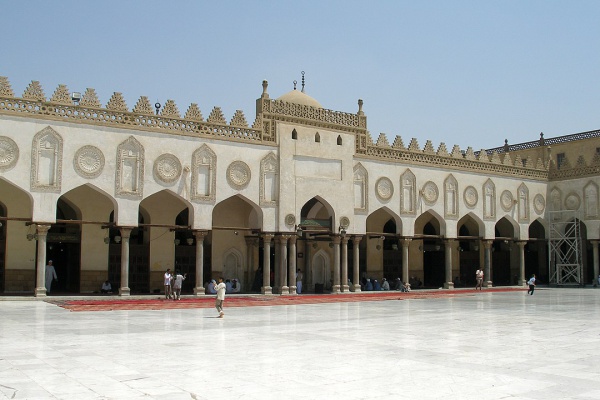“I cannot live without books” – Thomas Jefferson
The Muslim world learned the art of papermaking and typography back in the VIII century (this is about Persia). It was Muslims who introduced paper production to India and all Europe. The first public libraries emerged in Baghdad, Cairo and Cordoba. Their shelves were full of books, which were made of paper. Due to the religious ban on images of living beings, calligraphy was one of the indispensable attributes of books in such libraries.
In general, the word “library” itself is derived from the Latin “liber”, which means “a book”, while “bibliotheca” is a Greek word, which is also widely used in the German and Romance languages.
Public libraries in the Muslim world were widely known under various names, such as Bayt al-Hikmah, Khizanat al-Hikmah, or Dar al-Hikmah, or Dar al- ‘ilm, Dar al-Kutub, Khizanat al-Kutub and Bayt al-Kutub, kitab-khana (Iran), Kutuphane (Turkey). These institutions were madrasahs, public and private libraries, palace libraries and imperial libraries.
The first Arab library was founded by Umayyad Caliph Muawiah ibn abi Sufiyan (602-680) in Damascus. The majority of the book industry revolved around mosques. Some libraries very often were a part of temples. In such cases, their main purpose was copying of books from Greek, Pahlavi, Syriac and Sanskrit into Arabic. Lections, debates and discussions on a wide range of religious, scientific and philosophical issues of those times were debated in mosques, which also served as courts. According to legendary traveler of the XIV century Ibn Battuta, the Damascus book market was located near the Great Umayyad Mosque. Apart from books, merchants sold there everything that could be needed in the literary field – from reed pens, inks, leather, hard paper and glue to fine paper. Traditionally, Muslims bequeathed their book collections to mosques.
There were three great libraries in the Muslim world: the Abbasid library “House of Wisdom” in Baghdad, the library of Fatimid Caliphs in Cairo and library of Spanish Umayyad Caliphs in Cordoba.
Since the IX century, many more libraries housed books of exact sciences. Some of those libraries were private; the others were established by Caliphs, Emirs (in other words, governors), Sultans and Viziers. For instance, there was a large library called “Khizanat Al-Kutub” in Abbasid Mosul.
By the X century, there had emerged a great number of libraries and schools, which were founded in Basra, Isfahan, Nishapur, Rayy, Damascus and Cairo. Some of the books in such libraries were listed by Ibn al-Nadim in his bibliographical compilation “Kitab al-Fihrist” and in Ibn al-Qifti’s biographies of scientists and philosophers “Ta’rikh al-Hukama”, Ibn Abi Usaybiyah’s “Uyun al-Anba’ fi-Tabaqat al-Atibba” and by Ibn Juljul’s “Tabaqat al-Atibba’ wa’l-Hukama”. These works contain biographical and bibliographical information about Muslim scholars and philosophers of all ethnic groups up to the XIII century. Modern historians and bibliographers of Islamic science, including George Sarton, Carl Brockelmann and Fuat Sezgin, have identified and made a list of manuscripts and printed books on the history of Islamic science.
1. Al-Qarawiyyan – one of the most ancient libraries in the world

Reda.bnhd/Creative Commons 4.0
The Al-Qarawiyyan library was established in 859 in Fez, Morocco, by Fatima El-Fihriya, daughter of a rich immigrant from modern-day Tunis. Considered to be the most ancient library in Africa, the Al-Qarawiyyan also holds the distinction of being the world’s oldest working library, which means that it has been always used since the moment of its establishment.
The founder, El-Fihriya, was well-educated; a scholar and devout Muslim who decided to dedicate her rich inheritance to the development of religious and scientific education. She established an educational centre and a library, holding ancient manuscripts on theology, law, astronomy and grammar that date as far back as the VII century. The most notable among them are “Muqadimmah” by Ibn Khaldun of the XIV century, the Quran of the IX century written in Kufic calligraphy, and a manuscript on the Maliki School of Islamic jurisprudence by Spanish jurist and philosopher Ibn Rushd (1198).
The Al-Qarawiyyan complex enlarged over the centuries today includes a mosque, a library and a university. According to UNESCO, it is the oldest working educational institution in the world.
Poet and philosopher Ibn al-Arabi (1165-1240) studied there in the XII century; historian and economist Ibn Khaldun got knowledge in the XIV century, while in medieval times, the Al-Qarawiyyan played a leading role in the transfer of knowledge between Muslims and Europeans. Over the centuries, the building had been in decline and environmental factors ravaged its contents but the historical manuscripts always remained available to scholars and academics.
Recently, the Moroccan government commissioned a Canadian architect of Moroccan origin Professor Aziza Chaouni, to renovate and restore the library, returning it to its architectural grandeur. Chaouni undertook to restore the main features of the building, such as the fountains in the courtyard, intricate tile work and the dome of the XII century. The restored library, which took nearly four years to complete, reopened for public in May of the year 2016.
Today, the library is working extensively on digitizing ancient manuscripts in order to make them available to the whole world. About 20% of them are now available in electronic format.
2. Baytul Hikma (the House of Wisdom), Baghdad
“The House of Wisdom” was established by Caliph Harun al-Rashid and culminated under his so Caliph al-Mamun, who is credited with its formal institution. Al-Mamun is also credited with bringing many well-known scholars to exchange information, ideas and culture in the House of Wisdom. Besides Muslim scholars, Hindu, Jewish and Christian researchers could study here. They translated books into the Arabic language and preserved them, helping to spread knowledge.
Baytul Hikma consisted of a library, a translation bureau, observatories, reading rooms, living quarters for scientists and administration buildings. One of the scientists that used to work there was Elan al-Sha’oobi. Under his supervision ancient manuscripts were copied. Abu Sahal and Abu al-Fazal bin Naubakht were delegated with the task of expanding the library. Influential Minister Yahya bin Khalid Barmaki invited Hindu scholars and ordered Sanskrit books to be translated into the Arabic language. Because Yahya Barmaki was Iranian, he had a lot of Persian works, having been translated into Arabic by Abu Sahal and Abul-Fazal. When Harun al-Rashid received books about his adventures in Rome and Amudiyya, he instructed physician Yohanna ma-Sawiyya to translate those Greek works into the Arabic language.
Baytul Hikma had in its treasures works on almost every subject and in every language. Harun al-Rashid sent envoys to various countries to procure books. Apart from rare manuscripts in Arabic, he acquired manuscripts in Sanskrit, Persian, Syriac and Coptic languages by paying the highest price for each book.
Attached to the library there was the translation bureau where famous scholars and outstanding translators rendered books into the Arabic language. There were Hindu, Christian, Jewish and Parsi scholars who were equally deemed estimable. They were paid handsome salaries. Ibn al-Nadeem in his famous “Kitab al-Fihrist” (index of books up to 987) and Ottoman scholar Haji Khalifa (Kâtip Çelebi 1657) in his “Kasha al-Zanoon” listed all the books which had been translated there.
After Caliph Harun al-Rashid’s death (809), his successor Mamun al-Rashid (833) purchased for the library rare manuscripts, such as poems from pre-Islamic era, eulogies, government documents, letters and agreements between states. For instance, there was a loan payment agreement signed by Abdul Muttalib bin Hashim (578), grandfather of Prophet Muhammad. Caliph Mamun requested the ruler of Sicily to send all those books which were locked in an abandoned house on the island and nobody had access to it. Having received those works, Mamun gave that treasure to Sahal bin Haroon for translation as he was director of the library. When Mamun prevailed in the war against the Byzantines, he stipulated in the peace treaties that certain Greek manuscripts would be sent to Baghdad. For that purpose, there was chosen mathematician and translator Al-Hajjaj Ibn Yusuf ibn Matar.
Staff of Bayt al-Hikma included a director, scribes, translators, astronomers, scholars and book binders. There worked people of different confessions, such as Parsi, Christian, Jews and Hindus, of which Hunayn ibn Ishaq, Hakim Royani, Yohanna ma-Sawiyya, Qusta ibn Luqa, Sahal bin Haroon and abu Jaafar bin Adi, Musa al-Khawrizmi, al-Fadl ibn Nawbakht, Mashallah are best known. Teaching there included theology, algebra, geometry, physics, biology, medicine and logic.
3. Harun al-Rashid’s vizier Yahya ibn Khalid Barmaki (806) had a large library in his disposal, which was decorated with volumes in Greek, Coptik, Sanskrit and Farsi. There were three copies of each book. When a new book came out, it was first shown to Yahya Barmaki as he was the only person who was ready to pay a thousand dirhams for any new book. Under his influence, the Caliph invited to Baghdad a lot of Buddhist scholars from India who prepared Kitab al-Budd, biography of Buddha. The philosopher of the Arabs and the first Muslim scholar who managed to reconcile faith and reason, Yaqub ibn Ishaq al-Kindi had a rich personal library, which was confiscated by jealous Banu Musa brothers and later returned to him.
4. Caliph Mutwakkil’s (822-861) companion Fatah ibn Khaqan established a library in Baghdad (Sahib khazanatul Kutub), the director of which was famous scientist Ali ibn Yahya Munajjam. Khaqan was a passionate reader and “the greatest bibliophile of his day”. Ali ibn Yahya had his personal library, so he transferred many of his books to Ibn Khaqan’s library. Many scientists wrote books especially for the library. One of such researchers was prose writer and zoologist Abu Usman ibn Jahiz. Unfortunately, in 1063 this library was pillaged by soldiers of Tughral Beg Saljooki.
5. Ali ibn Yahya Munajjam was the director of Ibn Khakan library. His personal library in Baghdad was called Khazanatul Kutub. People from other countries came to see the library, stayed there for a long time and got knowledge, enriched there spiritually and morally. Researchers and scientists say that greatest astrologer of Abbasid court Abu Ma’shar al-Falki while going for Hajj from Khurasan especially stayed in Baghdad in order to visit that unique library.
6. Ishaq Mosul was a prominent musician and a master of hadiths and grammar. There were incomparable grammar books in his Baghdad library.
7. Vizier Sabur bin Ardsher established in 894 in Karkh district (Baghdad) a library which was called Dar’ul Ilm. They say that there were about ten thousands of titles in that library. Every author donated a copy of his book. There were 100 hand written copies of the Quran in the library. Leading scientists, philosophers and intellectual of Baghdad gathered there to debate and discuss the main issues in various fields of knowledge. Famous blind writer, philosopher and poet from Aleppo, Abul A’la al-Ma’arri used that library.
8. Muhammad bin Hussain al-Baghdadi’s library housed manuscripts and documents. Nobody had access to them, except several scientists. Ibn Nadim writes that he got permission from the owner with great difficulty. He gave more details about the work of the library in his well-known work “Al-Fihrist”.
9. Library of Mustansariyya madrasah was founded by 36th Abbasid Caliph al-Mustansir Bi’llah in 1227 on the left bank of Tigris River. When construction and finishing works were completed, the opening ceremony was held. Leading scholars and jurists were appointed to give lections. All the books from the royal library were loaded on 130 camels and deposited in the magnificent library. There were 80 000 rare and valuable manuscripts, one of which was hand written copy of Tarikh-e-Baghdad wa-Madinatul Islam (24 volumes, 7831 biographies, including titles of books and names of authors) by Abi Bakr al-Khatib al-Baghdadi.

Taisir Mahdi/Creative Commons 4.0
The library survived the Mongol incursion. It was merged with that of Nizamiyah Madrasah in 1393. After the Ottomans captured Baghdad in 1534, books from palaces and libraries were taken as the spoils of war in order to become an important part of the royal library in Istanbul, and Al-Mustansiriyah was closed. The Mustansriya Madrasah is still functioning in a new building and now is a part of the Al-Mustansiriya University.
10. Libraries of Cairo Fatimid Caliphs were home for scholars and researchers. Caliph Abu Mansur nizar al-Aziz Bi’llah was also a scientist. He wrote poems, copied books and established a library in his palace in Cairo Khazai’n al-Qasoor, consisting of 40 rooms full of books on jurisprudence, grammar, literature, science of hadith, history, astronomy and chemistry. There were about 200 000 volumes, of which 6 000 were on mathematics and astronomy. There were 30 copies of Khalil ibn Ahmad Nahvi’s “Kitab al-Ain”, one volume of which was hand written by the author. One could find 1 200 copies of Tarikh-e-Tabari and 2 400 copies of the Glorious Quran. Some books had binding of gold with silver paintings. There were also 2 globes in the library. One of them was made of silver and cost 3 000 dinars, another one was made by Greek astronomer Ptolemy. The doors were open 24 hours for students. After al-Aziz Bi’llah’s death, the collection was transferred to the library of his successor al-Hakim bi-Amr Allah.
Al-Hakim bi-Amr Allah founded a library in Cairo Darul Hikma (the Hall of Science and Wisdom). The inauguration was attended by famous scientists, jurists and doctors. Patrons were allowed not only to read books, but also to copy them if it was necessary. Feather, ink and paper were provided for that purpose. Many doctors, jurists, logicians, astronomers and mathematicians worked there. Once Al-Hakim bi-Amr Allah invited scholars for a debate, at the end of which everyone was given large sums of money.
11. Jami’ah al-Azhar was founded in 970 during the time of Caliph Muizz al-din Allah. His library housed more than two hundred thousand volumes. There was no other library as al-Azhar in the entire Muslim world.

Vyacheslav Argenberg/Creative Commons 4.0
All the old schools and libraries in Egypt were destroyed except this one. During the time of al-Mustansir bi-Allah Turkish soldiers plundered the library. Hundreds of books were mercilessly thrown in the river Nile or burnt. Those that were saved formed a heap in open space, which afterwards was called Tilal al-Kutub (heap of books). Despite this, hundreds of books from caliphal libraries survived so much that Sultan Salah al-Din ibn Ayub bestowed on his secretary and counselor al-Qadi al-Fadil 120 000 manuscripts for his madrasah Qaf.
Although Al-Azhar university was founded in 1961, its library had been founded in 1005 by the ruling Fatimids. And that is almost 600 years before Oxford’s Bodleian library and 440 years before the Vatican library were established. According to some counts, its collection includes 9 062 books and 595 668 manuscripts, dating to at least the VIII century.
12. Mahmudiyya library of Cairo housed hundreds of rare objects. Although it had a collection of 4000 volumes, many of them were hand written by authors. Several prominent scholars were directors of that library. One of them was Sheikh al-Islam Hafiz ibn Hajar al-Asqalani, who prepared two catalogues of the library. One catalogue was in the alphabetical order, the other one – according to subject matter. The library was a part of madrasah Mahmudiyya which was founded by an Egyptian statesman Jamal al-Din Mahmud, a close advisor of Sultan Malik al-Zahir Sayf al-din Barquq.
To be continued…
Ilmira Gafiyatullina
Photo in slider: Michal Jarmoluk/Pixabay
